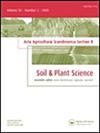不同生长条件和控制强度对谷物杂草发育的影响
IF 1.8
4区 农林科学
Q2 AGRONOMY
Acta Agriculturae Scandinavica Section B-Soil and Plant Science
Pub Date : 1999-01-01
DOI:10.1080/09064719909362509
引用次数: 9
摘要
在挪威的四个地点对谷物杂草群落的发展进行了5年的调查。每年在相同的地块上分别施用正常剂量的0、1/3、2/3或3/3的除草剂。出现的杂草种类因年份和地点而异,但不受处理的影响。各田区杂草株数和单株频次均存在差异,但不同田区、不同剂量、不同年份的变化差异较大。低剂量除草剂增加了种子库,而高剂量除草剂对种子库没有影响。杂草出苗率随时间的延长而降低,但不同田间差异较大。未处理地块的出苗率低于处理地块。前几年的杂草丰度和种子库的大小影响植株数量,但播种后的气温也同样重要。耕前春季土壤温度对杂草出苗也有影响。本文章由计算机程序翻译,如有差异,请以英文原文为准。
Weed development in cereals under different growth conditions and control intensities
The development of weed communities in cereals was investigated over 5 years at four locations in Norway. Each year the same plots were treated with 0, 1/3, 2/3 or 3/3 of the ‘normal’ dose of either of two herbicides. The weed species that emerged varied between years and locations, but were unaffected by treatments. The total number of weed plants and the frequency of individual species varied in all fields, but the changes differed greatly between fields, dosages and years. The seed bank was increased by the lowest herbicide dose and unaffected by the higher doses. The percentage of emerged weeds decreased with time, but varied between the fields. The per cent emergence was lower on untreated than on treated plots. The weed abundance in previous years and the size of the seed bank affected the plant number, but the air temperature after sowing was just as important. Even soil temperature in spring prior to tillage influenced weed emergence.
求助全文
通过发布文献求助,成功后即可免费获取论文全文。
去求助
来源期刊
CiteScore
4.40
自引率
0.00%
发文量
56
审稿时长
2.3 months
期刊介绍:
Acta Agriculturæ Scandinavica Section B publishes original research in applied soil and plant science with special attention given to to crop production in agri- and horticultural systems. We welcome manuscripts dealing with:
Climate smart and sustainable crop production systems
Water and nutrient efficiency
Soil conservation and productivity
Precise agriculture systems
Applications of bio- and nanotechnology
Digitalisation and robotics
Soil-plant interactions
Acta Agriculturæ Scandinavica, Section B – Soil & Plant Science forms part of a series of titles published on behalf of the Nordic Association of Agricultural Science (NJF). The series also includes Section A - Animal Science .

 求助内容:
求助内容: 应助结果提醒方式:
应助结果提醒方式:


